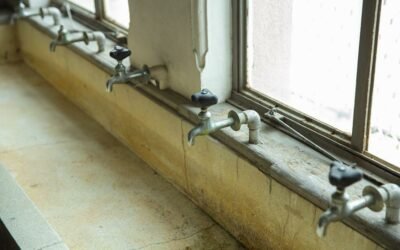Are you dealing with mold on your couch? Don't worry, you can get rid of it!
In this article, we'll guide you through the signs of mold on a couch, how to prepare your couch for mold removal, and DIY methods to effectively eliminate mold.
We'll also explore professional mold remediation options and provide tips to prevent mold growth on your couch.
Get ready to say goodbye to mold and hello to a clean, healthy couch!
Key Takeaways
- Visible signs of mold on a couch include black or green growth, discoloration or unusual spots, fuzzy or slimy patches, and water stains on the fabric.
- Before removing mold from a couch, it is important to thoroughly inspect the affected areas, remove loose items to prevent cross-contamination, vacuum the couch with a HEPA filter, and address any moisture issues or water damage.
- DIY methods to remove mold from a couch include vacuuming with a HEPA filter, using a vinegar and water mixture, applying a baking soda paste, and exposing the couch to direct sunlight and fresh air.
- Professional mold remediation for couches involves assessment, containment, removal, cleaning and treatment using antimicrobial products, and choosing a reputable and certified mold remediation company.
Signs of Mold on a Couch
Look for visible patches of black or green growth on your couch. Mold can easily grow in damp, dark environments, and your couch could be the perfect breeding ground. Check the cushions, the backrest, and the armrests for any signs of discoloration or unusual spots. Mold often appears as fuzzy or slimy patches, and it may have a musty odor. If you notice any of these signs, it's likely that your couch has been affected by mold.
Another indicator of mold growth is the presence of water stains on the fabric. These stains may be a result of a previous water leak or excessive moisture in the air. Mold thrives in moist conditions, so if there are water stains on your couch, it's important to address the issue promptly.
Furthermore, pay attention to any allergic reactions or respiratory symptoms that you or your family members may be experiencing. Mold spores can cause allergic reactions, such as sneezing, coughing, and itchy eyes. If you notice an increase in these symptoms when you're near your couch, it could be a sign of mold contamination.
Preparing Your Couch for Mold Removal
To begin preparing your couch for mold removal, start by thoroughly inspecting the affected areas. Look for any visible signs of mold, such as black or green spots, musty odors, or discoloration on the surface of the couch. Take note of the extent of the mold growth and determine whether it has spread to other parts of the couch or surrounding furniture.
Next, remove any loose items from the couch, such as pillows, cushions, or blankets. These items may harbor mold spores and can contribute to the spread of mold if not properly cleaned or discarded. Place them in a separate bag or container to prevent cross-contamination.
Using a vacuum cleaner with a HEPA filter, carefully vacuum the entire couch, paying close attention to the affected areas. This will help remove any loose mold spores and debris. Be sure to clean the vacuum cleaner thoroughly afterward to prevent the spread of mold to other areas of your home.
Once the couch has been vacuumed, it's important to address any moisture issues that may have contributed to the mold growth. If the couch is upholstered with fabric, check for any signs of water damage or dampness. If necessary, use a dehumidifier or fan to dry out the affected areas before proceeding with mold removal.
DIY Methods to Remove Mold From a Couch
Once you've prepared your couch for mold removal, it's time to delve into DIY methods to effectively remove mold from your couch. Mold can be harmful to your health and damaging to your furniture, so it's crucial to address the issue promptly.
Here are four effective ways to remove mold from your couch:
- Vacuum with a HEPA filter: Start by vacuuming the affected areas using a vacuum cleaner with a HEPA filter. This will help remove loose mold spores and prevent them from spreading further.
- Use a mixture of vinegar and water: Mix equal parts of white vinegar and water in a spray bottle. Spray the solution onto the moldy areas of your couch and let it sit for at least an hour. Afterward, scrub the mold with a soft brush and wipe clean with a damp cloth.
- Apply a baking soda paste: Create a paste by mixing baking soda with water. Apply the paste to the moldy areas and let it sit for a few hours. Then, scrub the mold with a brush and wipe clean with a damp cloth.
- Sunlight and fresh air: If possible, place your couch outside in direct sunlight and fresh air. The UV rays from the sun will help kill mold spores, while the fresh air will aid in drying out the couch.
Professional Mold Remediation for Couches
For effective mold remediation for your couch, consider hiring a professional. Mold can be stubborn and difficult to completely remove, especially from porous surfaces like upholstery. Professionals have the expertise and specialized equipment to effectively eliminate mold and prevent its recurrence. Here is a brief overview of the professional mold remediation process for couches:
| Step | Description |
|---|---|
| 1 | Assessment: A professional will inspect the couch to determine the extent of the mold infestation and identify the type of mold present. |
| 2 | Containment: The affected area will be isolated to prevent mold spores from spreading to other parts of your home. |
| 3 | Removal: The professional will carefully remove the mold from the couch using appropriate techniques and products. They will also address any underlying causes of the mold growth, such as moisture issues. |
| 4 | Cleaning and Treatment: The couch will be thoroughly cleaned and treated with antimicrobial products to kill any remaining mold spores and prevent future growth. |
Professional mold remediation ensures a thorough and effective treatment, minimizing the risk of health issues and further damage to your couch. It is important to choose a reputable and certified mold remediation company to ensure the best results.
Preventing Mold Growth on Your Couch
To prevent mold growth on your couch, regularly clean and maintain it to minimize moisture and humidity. Mold thrives in damp environments, so it's important to take proactive measures to keep your couch dry. Here are four essential steps to prevent mold growth on your couch:
- Vacuum regularly: Use a vacuum cleaner with a HEPA filter to remove dust, dirt, and debris from your couch. This will help prevent mold spores from settling on the surface and creating a breeding ground for mold.
- Keep your couch dry: Avoid spilling liquids on your couch and promptly clean up any spills. If your couch gets wet, use a clean towel to blot the moisture and allow it to air dry completely. Avoid placing your couch near sources of moisture, such as windows or leaky pipes.
- Maintain proper ventilation: Ensure that the area where your couch is placed has good airflow. Open windows, use fans, or consider using a dehumidifier to reduce humidity levels. Mold thrives in humid environments, so keeping the air circulating can help prevent mold growth.
- Use mold-resistant materials: When purchasing a couch, opt for materials that are resistant to mold and mildew. Look for couches made with synthetic fabrics or treated with mold-resistant coatings. These materials are less likely to provide a suitable environment for mold growth.
Conclusion
In conclusion, it's possible to remove mold from a couch using DIY methods or professional mold remediation services. Signs of mold on a couch should be addressed promptly to prevent further damage and potential health risks.
Preparing the couch for mold removal is crucial, and following proper safety procedures is recommended. Regularly cleaning and maintaining your couch can help prevent mold growth in the future.






0 Comments